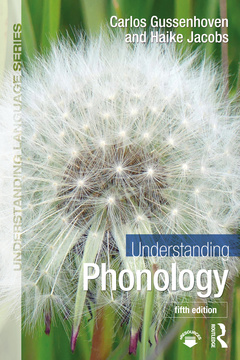Understanding Phonology (5th Ed.) Understanding Language Series
Auteurs : Gussenhoven Carlos, Jacobs Haike

Understanding Phonology, Fifth Edition, provides a clear, accessible and broad introduction to phonology. Introducing basic concepts, it provides a comprehensive account of phonological topics like segmental contrasts; syllables and moras; quantity; tone and intonation; word stress; and prosodic constituent structure. This new edition has been streamlined to match widely applied course requirements. Key features include:
? Reorganised chapters to introduce key concepts earlier and increase accessibility to beginning students
? New developments and an updated bibliography
? Illustrations from languages spoken all over the planet, including Arabic, Central Alaskan Yupik, Hawaiian, Mandarin, French, Nubi, Yabem, Yanyuwa, and Zulu
? Over 100 exercises to test understanding
? A consistent illustration of Optimality Theory as applied to word stress
? Updated online resources for students and instructors including audio files, a key to questions, teaching goals, and PowerPoint slides.
Understanding Phonology is essential reading for students coming to this topic for the first time.
Preface
Acknowledgements
The IPA Chart
1. Structures in languages
1.1 Introduction
1.2 Awareness of linguistic structure
1.3 Language diversity
1.4 What linguists do
1.4.1 Language-external evidence
1.4.2 Language-internal evidence
1.5 Morphosyntactic structure
1.5.1 Morphemes and words
1.5.2 Syntax: phrases, clauses and sentences
1.5.3 Some mismatches between phonology and morphosyntax in English
1.6 Changing sounds
1.7 Conclusion
2. The production of speech
2.1 Introduction
2.2 The lungs and the larynx
2.2.1 The vocal folds: the open and vibrating glottis
2.2.2 Devoicing and aspiration
2.2.3 Special types of phonation
2.2.4 Pitch
2.2.5 The glottal stop
2.3 The vocal tract
2.3.1 The pharynx
2.3.2 The nasal cavity
2.3.3 The mouth
2.4 Vowels
2.4.1 Monophthongs
2.4.2 Diphthongs
2.4.3 Nasalization
2.5 Consonants
2.5.1 Places of articulation
2.5.2 Types of constriction
2.6 Segmental durations
2.7 Complex consonants
2.7.1 Secondary articulations
2.7.2 Double articulations
2.7.3 Manner-contour consonants
2.8 Nonpulmonic consonants
2.9 Conclusion
3. Some typology: sameness and difference
3.1 Introduction
3.2 Varying complexity
3.3 Universals and implicational relations
3.3.1 Plain or special?
3.3.2 Avoiding complexity
3.3.3 A word of caution
3.3.4 Speech ergonomics
3.3.5 System gaps
3.4 Cultural and ambient factors in the development of sound systems
3.5 Conclusion
4. The varying shapes of sounds and words
4.1 Introduction
4.2 Allophonic variation
4.3 Loanword adaptation
4.3.1 The process of nativization
4.4 Morpheme alternants
4.5 The underlying form
4.5.1 Choosing the underlying form
4.5.2 Grammars vs ‘dictionaries’
4.6 Conclusion
5. A system of distinctive features
5.1 Introduction
5.2 Features for consonants
5.2.1 Major class features
5.2.2 Laryngeal features
5.2.3 Manner features
5.2.4 Place of articulation features
5.3 Features for vowels
5.4 Redundant vs contrastive features
5.5 Complex segments
5.6 Conclusion
6. Making the form fit: serial rules or violable constraints?
6.1 Introduction
6.2 Serial rule application
6.2.1 Rule formats
6.2.2 Serial rule ordering
6.3 Constraints
6.3.1 Tableaux
6.3.2 OT and loanwords
6.4 Serial rules or ranked constraints?
6.5 Conclusion
7. Lexical phonology, postlexical phonology and phonetic implementation
7.1 Introduction
7.2 Defining an intermediate level of representation
7.3 Lexical Phonology
7.3.1 Reference to morphological labels
7.3.2 Exceptions
7.3.3 Structure preservation
7.3.4 Native-speaker intuitions
7.3.5 Application across word boundaries
7.3.6 Lexical rules apply before postlexical rules
7.4 Reference to phonological information in the lexicon
7.5 Beyond surface representations
7.5.1 Models of implementation
7.5.2 Deciding between phonology and phonetic implementation
7.6 Conclusion
8. Between the segment and the syllable
8.1 Introduction
8.2 Syllabification and the Maximum Onset Principle
8.2.1 The Sonority Profile
8.3 Expanding the representations: hierarchies and autosegments
8.3.1 Skeletal slots
8.3.2 Autosegments
8.3.3 Unfilled and unassociated slots
8.3.4 Compensatory lengthening
8.4 Moras
8.5 Syllable-based generalizations
8.6 Post-MOP syllabification rules
8.7 Conclusion
9. Tones
9.1 Introduction
9.2 The inadequacy of a linear model
9.3 Word melodies
9.3.1 Language-specific association
9.4 Tone stability
9.5 Tonal morphemes
9.6 Accent
9.7 The phonetic implementation of tone
9.7.1 The vertical dimension: scaling
9.7.2 The horizontal dimension: phonetic alignment
9.8 Not by f0 alone
9.8.1 Voice quality
9.8.2 f0 perturbations and tone distribution
9.9 Conclusion
10. Word stress
10.1 Introduction
10.2 Primary stress, secondary stress and no stress in English
10.3 Basic dimensions of foot structures
10.3.1 Foot type
10.3.2 Aligning words and feet
10.4 Syllable weight
10.4.1 Uneven feet?
10.5 Stress clash
10.6 Unbounded systems
10.7 The roles of morphology
10.8 Interactions of stress with segments and tones
10.8.2 H-tones attracting stress
10.9 Conclusion
11. Phonology above the word
11.1 Introduction
11.2 Generalizations involving prosodic constituents
11.3 The Strict Layer Hypothesis
11.4 Factors determining prosodic phrasing
11.5 Prosody above the foot
11.5.1 The prosodic word
11.5.2 The phonological phrase
11.5.3 The intonation phrase
11.5.4 The phonological utterance
11.6 Deriving prosodic constituents
11.6.1 Clitics
11.6.2 The syntactic residue
11.7 Conclusion
References
Language Index
Subject Index
Carlos Gussenhoven is emeritus professor of general and experimental phonology at Radboud University Nijmegen, Netherlands.
Haike Jacobs is professor of French linguistics at Radboud University Nijmegen, Netherlands.
Date de parution : 07-2024
15.6x23.4 cm



